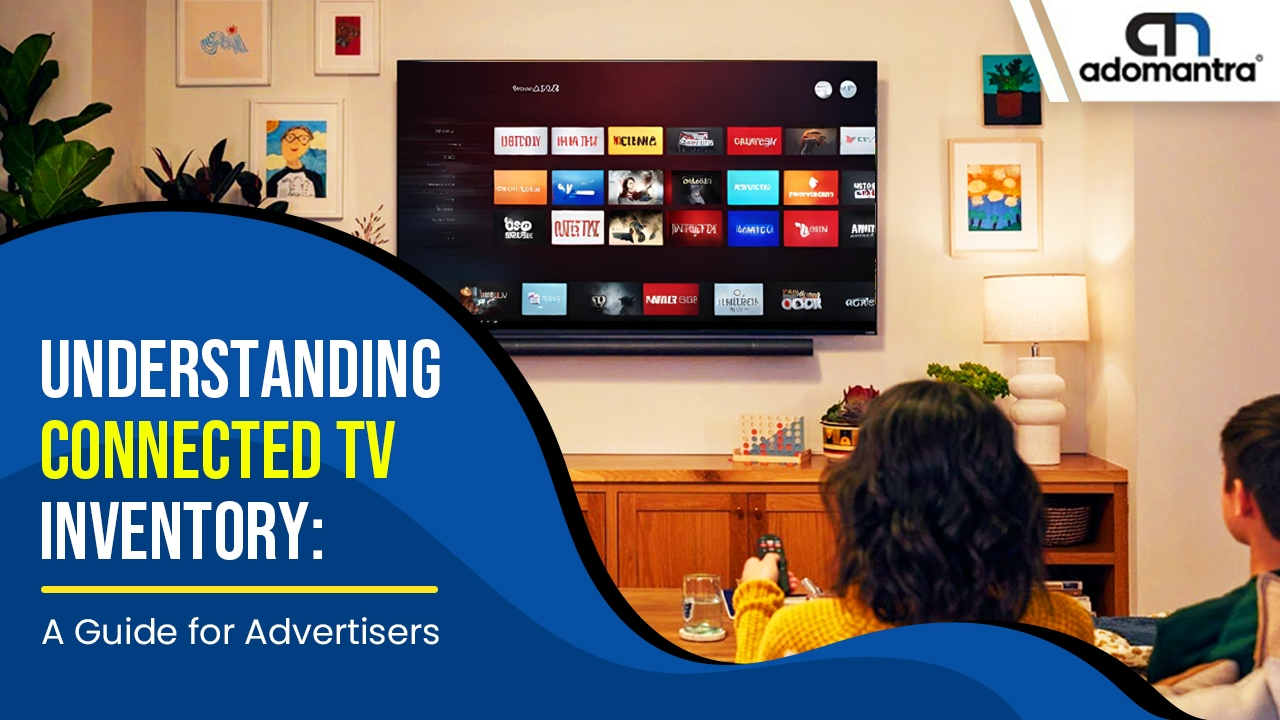
Understanding Connected TV Inventory: A Guide for Advertisers
Connected TV (CTV) is reshaping how advertisers connect with audiences. It’s no longer just about placing ads; it’s about engaging viewers in ways that feel relevant and impactful. With the rise of internet-connected platforms like Netflix, and YouTube TV, brands have the opportunity to directly reach audiences who are tuned in and ready to engage. This isn’t the broad, one-size-fits-all approach of traditional TV—it’s targeted, measurable, and incredibly powerful.
In this guide, we’ll take you through what CTV inventory is all about, how advertisers can make the most of it, and why it’s essential for brands that want to stay ahead. Keep reading to learn more!
Table of Contents
What is Connected TV Inventory?
How is CTV Inventory Bought and Sold?
Types of Ad Inventory Available on CTV
Differences Between CTV and Traditional TV Inventory
How Advertisers Can Maximize CTV Inventory
Why Partner with Adomantra?
Frequently Asked Questions
What is Connected TV Inventory?
When we talk about CTV inventory, we’re referring to the ad spaces available on internet-connected television platforms. These aren’t your typical TV commercials that reach anyone and everyone watching a particular channel. Instead, CTV advertising inventory allows brands to target their ads to specific audiences based on who they are, what they watch, and even where they live.
Think about it: your favorite streaming service knows your preferences, from your binge-watching habits to the genres you love most. Advertisers can use that data to deliver ads that feel relevant to you as a viewer. For businesses, this means their ads are more likely to be seen by the right people at the right time. It’s not about reaching millions blindly; it’s about making every impression count.
How is CTV Inventory Bought and Sold?
Buying CTV inventory is a more strategic process compared to traditional TV ads. Here’s how it typically works:
Programmatic Buying
This is an automated process where advanced platforms place ads in real-time based on data. It’s like having a matchmaker for your ads, ensuring they reach the audience most likely to engage. Programmatic buying is efficient, cost-effective, and precise.Direct Deals
Some advertisers prefer to work directly with publishers to secure prime CTV ad placements. This approach often guarantees visibility on popular content or during peak viewing times. While it’s less automated, it provides brands with greater control over where their ads appear.
These methods allow advertisers to choose what works best for their budget and goals, ensuring they get the most value from every campaign.
Read More : Programmatic Advertising Vs Google Display Network: Which is the Best Choice?
Types of Ad Inventory Available on CTV
One of the best things about CTV advertising inventory is the variety it offers. Advertisers can choose from different formats to suit their needs:
Pre-Roll Ads: These appear before the content starts and grab attention right away.
Mid-Roll Ads: Shown during a program, these feel seamless and less intrusive.
Post-Roll Ads: Delivered at the end of content, these leave a lasting impression.
Interactive Ads: Designed for engagement, these encourage viewers to take immediate action.
Dynamic Ads: These are personalized in real-time based on viewer demographics or interests.
Each format has its strengths, and the key is knowing which combination will resonate most with your audience.
How is CTV Inventory Different from Traditional TV Inventory?
The shift from traditional TV to CTV isn’t just technological—it’s transformational. Here’s how they differ:
Feature | Traditional TV | Connected TV |
Audience Targeting | Broad, generalized reach | Specific, data-driven targeting |
Measurement | Limited metrics available | Detailed, real-time analytics |
Flexibility | Fixed schedules | Ads delivered on-demand |
Interactivity | Static ads | Clickable, dynamic experiences |
With CTV inventory, advertisers have more control, better insights, and a clearer path to delivering impactful campaigns.
How Advertisers Can Maximize CTV Inventory
Getting the most out of your CTV inventory requires a thoughtful strategy. Here are some steps advertisers can take to ensure success:
Understand Your Audience
Use analytics to dive deep into who your audience is and what drives their decisions.Embrace Programmatic Tools
Automating ad placement saves time and ensures precise targeting.Mix Up Formats
Don’t stick to just one type of ad. Experiment with pre-roll, mid-roll, and interactive formats.Optimize for All Devices
Make sure your ads look great on every screen, from TVs to smartphones.Keep an Eye on Performance
Regularly track and refine your campaigns based on real-time data.
These tactics ensure your ads don’t just reach people—they resonate with them.
Why Partner with Adomantra?
At Adomantra, we specialize in crafting strategies that help brands succeed in the world of CTV advertising inventory. Whether you’re looking for precise targeting, impactful CTV ad placements, or advanced analytics, we have the tools and expertise to make it happen.
Your audience is already streaming. Are your ads reaching them? Let Adomantra help you tap into the full potential of CTV to grow your brand and drive meaningful results. Contact us today to get started!
Frequently Asked Questions
Q1. What is connected TV inventory?
A. CTV inventory refers to the ad spaces on internet-connected platforms like Netflix or Hulu, offering precise, targeted advertising.
Q2. How is CTV inventory bought and sold?
A. It can be purchased programmatically through automated platforms or via direct deals with publishers for premium placements.
Q3. What types of ad inventory are available on CTV?
A. Advertisers can use pre-roll, mid-roll, post-roll, interactive, and dynamic ads to engage audiences.
Q4. How is CTV inventory different from traditional TV inventory?
A. CTV provides data-driven targeting, real-time analytics, and interactive ad formats, unlike traditional TV’s broad and static approach.
Q5. How can advertisers maximize CTV inventory?
A. Advertisers can succeed by understanding their audience, using programmatic tools, diversifying ad formats, and continuously monitoring performance.







